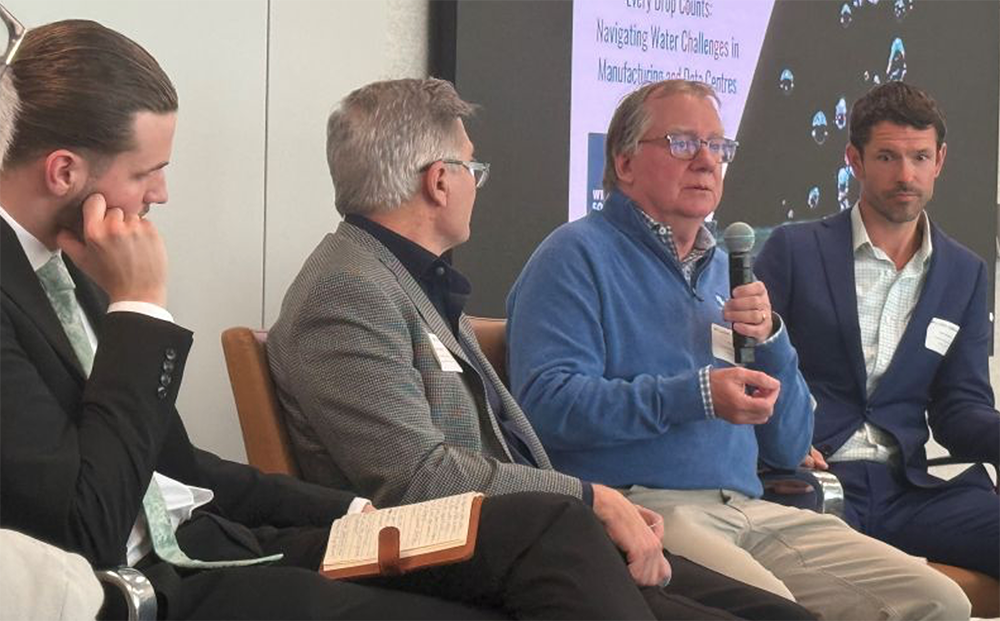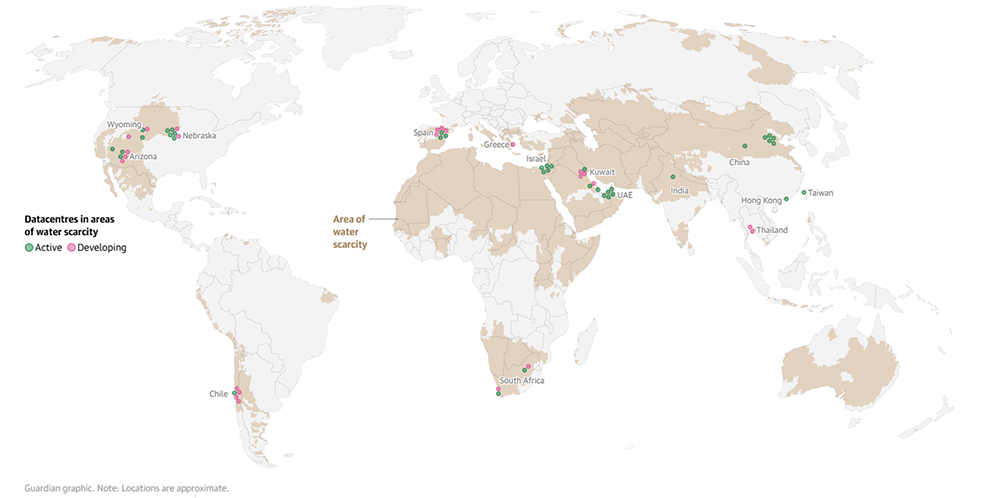On April 10th, Cleantech Group hosted the panel “Every Drop Counts: Navigating Water Challenges in Manufacturing and Data Centers,” in Palo Alto, California. Sponsored by Wilson Sonsini Goodrich & Rosati, the panel featured Chris Spain of HydroPoint, David C. Thompson of ChemTreat, and Jim Oliver of Black & Veatch.
Data centers were the focal point of the conversation. As OpenAI, Facebook, and Google require millions of gallons of water to cool their data centers, municipalities are running extreme risk of devastating water supplies for residents and commercial businesses alike. Data centers currently draw water from 90% of U.S. watersheds, increasing their total withdraws by 35% since 2018. Cities, states, and countries across the globe are committing to this unprecedented water use without clear foresight on what the consequences will be. Every Drop Counts was organized to help identify some pathways forward through this uncertainty.
Each speaker touched on the realities of resource constraints, public engagement, waste management, and partnerships as the key pillars on which successful data center projects are built. While it is impossible to summarize the brilliant discourse between the speakers, I will distill some key takeaways on each point.

Source: “Every Drop Counts” Panel picturing Parker Bovee, Chris Spain, Jim Oliver, and David C. Thompson. Photo from Steve Weiss
Power, Water, and Land
Jim Oliver kicked off his analysis on how data centers determine optimal location, pointing to power, water, and land availability as the core factors guiding decision making. Leaders in data center development follow this thesis closely, most often opting for former power stations or manufacturing facilities. Elon Musk’s xAI decided to locate the world’s largest data center in Memphis at a former Electrolux factory, partially for its natural gas availability. Similarly, Microsoft is developing two data centers in Leeds, England at former power stations while Amazon announced a data center at a former Virgina power station.
Power stations and former factories are prime targets for data centers for a few reasons. Development timelines can be fast tracked thanks to existing infrastructure such as grid interconnects, transmission lines, and substations, bypassing lengthy regulatory permitting processes. Former power sites are also equipped with extensive water infrastructure such as Google’s Jackson County data center, a former coal-fired power plant. While not a direct conversion, power plants’ location near water resources like lakes, rivers, and aquifers make data center renovation far more convenient than a full buildout.
Usually in remote settings, these former power stations also provide ample room for renovation and expansion with few neighbors. Remote coal plants and factories do pose a specific remediation challenge as they are often left with high soil and water contamination to be dealt with by new occupants.
Despite all these success stories, data centers are still built in areas of high-water scarcity. Figure 1 from the Guardian reflects approximately 632 data centers across the world in various stages of development or operation. While it is possible not all these projects will be constructed, a common theme of development in water scarce areas is emerging.
Figure 1: Projected and Current Data Center Locations in Water Scarce Regions

Source: Revealed: Big tech’s new data centres will take water from the world’s driest areas, The Guardian.
Public Engagement
Something each panelist noted was that communities are highly unlikely to react positively to requests to save water alongside news of data center development. Individual companies will need to focus on reducing waste in water use and find ways to incorporate communities in these efforts.
Companies must prioritize fitting into existing communities. Announcements for a Greystoke data center on intentionally undeveloped green corridors in Abbots Langley, England alienated entire communities, leading local authorities to reject construction permits. Similar community concerns over power and water use in Santiago, Chile forced delays on Google’s $200M data center investment. Communities are already making massive sacrifices, often forgoing the development of affordable housing to divert water to data centers or semiconductor fabricators. Reoccurring conflict between corporations and communities led to preemptive data center restrictions in Germany, the Netherlands, and Singapore.
Perhaps the best example of successful community engagement in data center development is Meta’s Prineville, Oregon facility. With slow growth over the last decade, Meta was public about expected resource use and encouraged critique from concerned citizens. Over the course of 14 years, the data center has roughly doubled in size with consistent job growth for Pineville through construction and service industries. Issues still exist, especially around water quality and scarcity, but Meta has been especially responsive to community recommendations. Recent critiques on possible water pollution from faulty discharge systems will put Meta’s community commitment to the test in coming months.
Waste Management
Jim stunned the audience by recounting difficulties with waste management in data centers. Specifically, he identified salt accumulation from cooling evaporation as a key hurdle for efficient operations. Jim was critical of data centers claiming the salt was a valuable byproduct to be valorized, citing salt build up as a critical concern that flies under the radar. Microsoft was forced to redesign part of their Washington data center operations after high brine discharge damaged local water supplies. David identified how facilities could prevent costly corrosion from these salts, tying up the unexpected insight perfectly.
Exploring reclaimed or recycled water was an unexpected takeaway from the panel. Data centers, like any other facility, operate with the limited resources available to them. ChemTreat focuses on this specific area, improving data center water efficiency using pretreatment or recycling of water supplies. Jim also provided a range of examples in which Black & Veatch helped data centers safely utilize salt or brackish water in their operations.
Partnership
Chris Spain had perhaps the most pointed takeaway of the panel as he addressed the very simple golden rule of water operations: stop wasting water. In fact, this is Hydropoint’s key value add. The company focuses on real-time water analytics, identifying water loss as it occurs. Chris was emphatic that existing infrastructure is failing and will need widespread digital support before and after it is replaced, a process that will likely span multiple decades nationally.
Chris made arguments beyond digitalization though. Citing waste as the key opponent, Chris advocated for creativity amongst players in the water value chain to optimize use. An excellent example of this is Meta’s Gallatin, Tennessee data center. The facility partnered with local waste treatment plants to divert non-potable water to Meta for use. Additionally, Meta equipped their facility with local water recycling and reuse technology stacks, further reducing daily freshwater intake.
Offsetting programs also play a huge role in data centers’ water use. Microsoft partnered with local municipalities, schools, and civil engineering firms to redesign several water systems in the state. While the renovations are designed to offset water use from new data centers, water recovery actually outpaced data center water intake in many cases, making the collaborations a victory for all parties involved.
Takeaways
Each speaker was emphatic that data centers were truly committed to long-term sustainability and collaboration with local actors. While mistakes and oversights were made throughout the last decade in planning, execution, or communication, Chris, Jim, and David stressed the progress made in foresight and planning from their data center clients. While it is unclear how data centers will evolve next in their water efficiency upgrades, two major themes to watch are direct-to-chip cooling and new regulatory oversight at both a state and federal level. Like most technologies in water, regulation is never too far behind the innovation curve so anticipate future conversation emphasizing regulatory control in infrastructure, planning, and water quality issues surrounding data centers.


